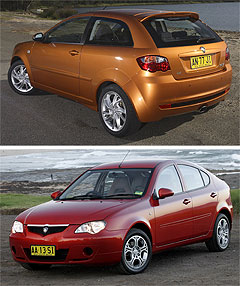Make / Model Search
Future models - Proton - SatriaProton plans new product onslaughtMore in store: New Satria completes phase one of Proton's self-designed model plan. Proton prepares to triple its future model program, pending its new partner26 Feb 2007 PROTON is embarking on an ambitious future model program that may see up to 20 new models launched within the next few years. Exactly what these models are, and when they will be released, hinges on which partner Proton chooses to collaborate with. A decision is expected from the Malaysian government – the owner of Proton – by early April. "It’s no secret that Proton is seeking a partner," Proton Cars Australia managing director John Startari says. "Our long-range product plan is going to be heavily influenced by whom that partner is."Currently speculation puts Peugeot as the main contender, after a premature announcement with Volkswagen in 2004 resulted in unresolved issues and an eventual termination of talks between the Malaysians and Germans in June last year. Volkswagen had said that it intended to manufacture models such as the Polo and Passat in Proton’s new state-of-the-art production facilities, but the Malaysians, keen to become a more self-sufficient automotive player, did not want to end up as a satellite factory outlet for the Germans. However, GoAuto understands that Proton and Volkswagen have since recommenced talks. General Motors is also believed to be interested in obtaining a South East Asian partner to complement its association with South Korea’s GM-DAT (the old Daewoo), although some pundits are saying that the Americans are interested in re-obtaining Proton Group's Lotus outfit – the British sports-car firm GM owned during the 1980s.  Left: Satria and Gen.2 (below). Left: Satria and Gen.2 (below).As outlined in GoAutoNews last month, Proton has been seeking to collaborate with a larger carmaker to find compatible platform architectures it could share, along with a new family of drivetrains. "In reality Proton cannot compete on the world stage with (its) low volumes," Mr Startari reveals. "A lot of the bigger manufacturers now have bases in low-cost countries, which really was Proton’s advantage, and they’re developing those countries with full research and development capabilities. "So a lot of that R&D cost is being reduced – in some cases 40 to 50 per cent – and that enables the bigger guys to do smaller runs of niche products – which was Proton’s advantage in the past," he said. The latest Satria, launched this month, is only Proton’s fourth all-new in-house design and engineering effort, and signals the end of the company’s ‘Phase One’ program of replacing its previously mostly Mitsubishi-based vehicles. With its Phase One models – the 2001 Waja small-car sedan, 2004 Gen.2 small-car hatchback, 2006 Savvy light car hatchback and this year’s Satria Neo – Proton took the highly unusual, expensive and time-consuming step of developing completely new platforms for each. From the four basic platforms introduced since 2001, along with a secret new one, Proton claims it can release up to 20 different model varieties, depending on who the partner is. There are already a number of new models in the pipeline. On the horizon for release this year is a facelifted Waja in August, featuring a new nose, upgraded trim and a series of mechanical modifications designed to increase power and efficiency. Proton is also expected to introduce a Gen.2 sedan to Australia by the end of this year. The Savvy hatchback will also gain a sedan counterpart soon, to slot into the market sector vacated by the 1983 Mitsubishi Mirage-based Saga range, Proton’s first vehicle and its basic entry-level car in Malaysia since the mid-1980s. A Satria GTI will arrive, powered by either a variation of the 100kW 2.0-litre twin-cam four-cylinder engine found in the outgoing Peugeot 206 GTI, or a turbo-charged 1.6-litre version of the CamPro engine. Perhaps the most important car for Proton, after the Satria Neo, will be the new-generation Jumbuck. To be built off the Gen.2’s front-wheel drive platform starting in 2008, the Jumbuck II will be slightly smaller than the existing model yet will feature a usefully larger cabin. The new Jumbuck will also feature a derivation of the hatchback’s 82kW/148Nm 1.6-litre four-cylinder engine. Today’s utility uses the 1992 Mitsubishi CC Lancer-derived body and platform, and runs the Japanese company’s 64kW/120Nm 1.5-litre single-cam unit. Despite the pending collaboration, Mr Startari was adamant that Proton in both Australia and globally will remain a fiercely independent concern. "Proton can still remain independent, but needs to be part of a bigger group to enjoy the economies of scale that large-scale purchasing (brings)," he said. "It can also fast-track (Proton’s) quality improvement program ... and that can only be enhanced further with a large group on board to share their learning. "There really is no substitute for experience in this business ... As far as we can see going forward, Proton in Australia will remain a wholly owned subsidiary of Proton Marketing (which is part of the Proton parent company in Malaysia). "We’ll remain promoting the cars and building the market share. We are quite fortunate that we have arrested the losses in this market and we are now in the position that we are quite profitable."
All future modelsMotor industry news |
Click to shareProton modelsResearch Proton All future modelsMotor industry news |
||||||||||

 Alfa Romeo
Alfa Romeo Abarth
Abarth Audi
Audi Aston Martin
Aston Martin BMW
BMW Bentley
Bentley Ferrari
Ferrari Chevrolet
Chevrolet Ford
Ford Fiat
Fiat GWM
GWM Foton
Foton Hyundai
Hyundai Honda
Honda Jaguar
Jaguar Isuzu
Isuzu Kia
Kia Jeep
Jeep Land Rover
Land Rover Lamborghini
Lamborghini Maserati
Maserati Lexus
Lexus McLaren
McLaren Mazda
Mazda Mercedes-Benz
Mercedes-Benz Mitsubishi
Mitsubishi Mini
Mini Peugeot
Peugeot Nissan
Nissan Ram
Ram Porsche
Porsche Rolls-Royce
Rolls-Royce Smart
Smart Skoda
Skoda Suzuki
Suzuki Subaru
Subaru Toyota
Toyota Tesla
Tesla Volvo
Volvo Zeekr
Zeekr







Facebook Twitter Instagram